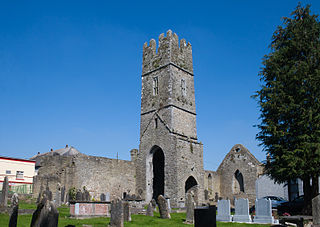
Askeaton, is a town in County Limerick, Ireland. The town on the N69, the road between Limerick and Tralee, is built on the banks of the River Deel some 3 km upstream from the estuary of the River Shannon.

Clane is a town in County Kildare, Ireland, 35.4 km (22 mi) from Dublin. Its population of 7,280 makes it the eighth largest town in Kildare and the 66th largest in Ireland. It is on the River Liffey. Clane gives its name to the associated townland, civil parish, electoral division and barony.

The Catholic Church in Ireland or Irish Catholic Church, is part of the worldwide Catholic Church in communion with the Holy See. With 3.7 million members, it is the largest Christian church in Ireland. In the Republic of Ireland's 2016 census, 78% of the population identified as Catholic; this was 6% lower than the 2011 figure. By contrast, 41% of people in Northern Ireland identified as Catholic at the 2011 census; it is expected that this proportion will increase in the coming years. The Archbishop of Armagh, as the Primate of All Ireland, has ceremonial precedence in the church. The church is administered on an all-Ireland basis. The Irish Catholic Bishops' Conference is a consultative body for ordinaries in Ireland.

The Synod of Kells took place in 1152, under the presidency of Giovanni Cardinal Paparoni, and continued the process begun at the Synod of Ráth Breasail (1111) of reforming the Irish church. The sessions were divided between the abbeys of Kells and Mellifont, and in later times the synod has been called the Synod of Kells-Mellifont and the Synod of Mellifont-Kells.
Events from the year 1224 in Ireland.

The Adare Friary, located in Adare, County Limerick, Ireland, formerly known as the "Black Abbey", is an Augustinian Friary founded in 1316 by the Earl of Kildare. It is now known as "St. Nicholas' Church of Ireland" parish church, and St Nicholas' National School.
Events from the year 1537 in Ireland.
Maurice Fitzmaurice FitzGerald I, 2nd Lord of Offaly was a Norman in Ireland peer, soldier, and Justiciar of Ireland from 1232 to 1245. He mustered many armies against the Irish, and due to his harsh methods as Justiciar, he received criticism from King Henry III of England. He was succeeded as Lord of Offaly by his son, Maurice FitzGerald, 3rd Lord of Offaly.

Moor Abbey Franciscan friary was founded in the 13th century in County Tipperary, Ireland. It is today a National Monument.

Carlingford Abbey, also called Carlingford Friary or Carlingford Priory, is a medieval Dominican abbey and National Monument located in Carlingford, County Louth, Ireland.

Creevelea Abbey is a medieval Franciscan friary and National Monument located in DromahairCounty Leitrim, Ireland. Creeveley Abbey is now in use for as a grave yard.

Lislaughtin Abbey is a medieval Franciscan friary and National Monument located in County Kerry, Ireland.

Ardfert Abbey is a medieval Franciscan friary and National Monument located in County Kerry, Ireland.

Roscrea Friary is a medieval Franciscan friary and National Monument located in Roscrea, Ireland. It is on Abbey Street, in the west end of Roscrea, on the north bank of the River Bunnow. The Friary was founded in the 15th century by Greyfriars (Franciscans) and later destroyed by British soldiers. What remains are the north and east walls and the bell-tower.

Portumna Abbey is a medieval Cistercian friary and National Monument located in Portumna, Ireland.

Kinalehin Friary, originally a medieval charterhouse or Carthusian monastery and later a Franciscan friary, is a National Monument located in County Galway, Ireland.

Dunmore Abbey is a medieval Augustinian friary and National Monument located in County Galway, Ireland.
Athy Priory is a former friary of the Dominican Order located in Athy, Ireland.

Askeaton Abbey or Askeaton Friary is a former Franciscan monastery and National Monument located in County Limerick, Ireland.


















